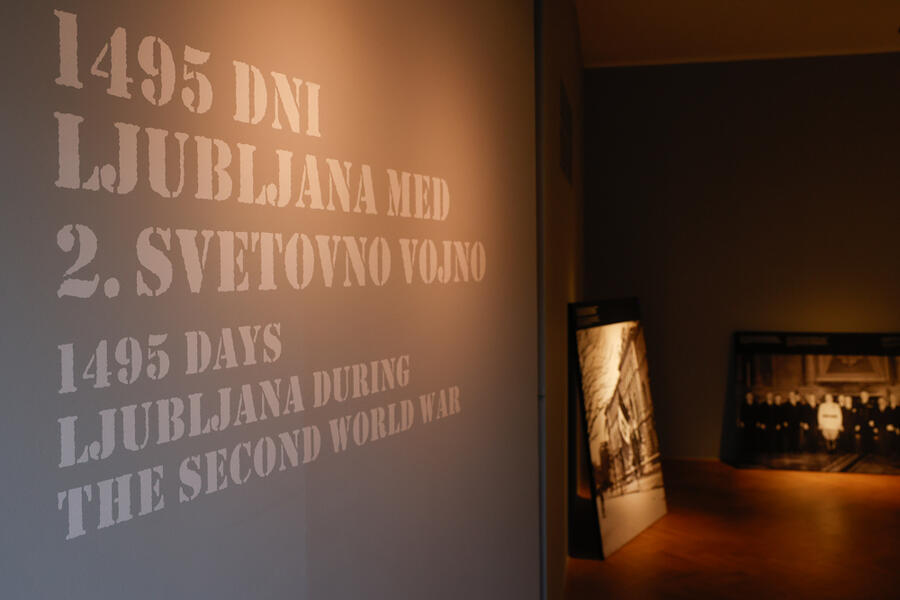1495 days: Ljubljana during World War II
On the 80th anniversary of the end of World War II, the City Museum of Ljubljana opened a central exhibition entitled 1495 Days: Ljubljana during World War II, which offers an in-depth insight into the key events between 1941 and 1945, which indelibly marked the history of our city.
Through objects, stories and rich photographic material, the exhibition uncovers the various layers of everyday life in wartime and reveals how diverse – and often contradictory – the experiences of Ljubljana's citizens were during the occupation.
»The exhibition about Ljubljana in World War II offers a comprehensive overview of the key events that marked the city during this period. It emphasizes the role of the people of Ljubljana and their fateful personal decisions in the development of events, as well as everyday survival during the occupation. It pays special attention to the real-life stories of individuals that speak to the visitor in a deeply personal way. At the same time, it encourages reflection on our responsibility in history and how we understand the past in light of the present,« said the author of the exhibition, Dr. Blaž Vurnik, curator of recent history at the City Museum of Ljubljana.
The museum presents the story of occupied Ljubljana through seven exhibition rooms, which put before visitors authentic objects, photographs, recordings and personal stories of citizens from the time of Italian and German occupation, which were donated to the museum collection over decades by individuals, from rebels and fighters to silent observers and those whose childhoods were marked by the war years.
The exhibition was created by designers Miran Mohar and Vadim Fiškin, who highlighted the design concept: »Documents and artefacts for the exhibition 1495 Days: Ljubljana during World War II are placed in display cases that resemble military crates and are arranged in strict order along the central axis of all six rooms. Pictures and maps are hung on panels that are »randomly« scattered throughout the rooms and only lean against the walls. Metaphorically, there are no walls, so there is nothing else except inscriptions on the walls. Occupation and war destroy the regular life of the inhabitants, so we did not use the walls to hang works. In the seventh room, there is a video projection of the arrival of the liberators in Ljubljana in May 1945, surrounded by photographs of the forest that do not require additional commentary.«
The exhibition further highlights the difficult times of war and deprivation through audio stories and video interviews, while interactive corners additionally allow visitors to delve deeper into its content. Intended for both adults and younger visitors, they remind us of how fragile peace, compassion and humanity are – and how important it is to safeguard them.
Part of the exhibited material was loaned to the City Museum of Ljubljana by the National Museum of Contemporary History of Slovenia, the Slovenian Film Archives at the Archives of the Republic of Slovenia, the Slovene Ethnographic Museum, the National and University Library, and private individuals. The exhibition will also feature important audio archival material – a concert by the Academic Choir conducted by France Marolt, which performed in the Union Hall on 11 December 1941; the event was secretly recorded by Rudi Omota, and the original recording is kept by Radio Slovenia.
Monograph 1495 Days: Ljubljana during World War II
Dr. Blaž Vurnik has also prepared a monograph for the exhibition, in which he comprehensively presents the political, economic, cultural and social events in Ljubljana during the Second World War. The text delves into the complexity of the time through descriptions of key events and phenomena, which are reminded of by archival and museum sources. The narrative includes numerous details that reveal the peculiarities of everyday life in the occupied city.
Statistical and factual data about the war in Ljubljana
• The title of the exhibition emphasizes the number of days that Ljubljana was caught in the grip of World War II – from 6 April 1941 to 9 May 1945.
• Between 1942 and 1943, the Italians shot around 150 hostages in Ljubljana. The shootings took place mostly in the Gravel Pit or at the shooting range on Dolenjska cesta.
• During the war, around 180 illegals – children of activists, partisans and internees – were hidden in Ljubljana; of these, only one was discovered by the Home Guard police.
• Between 25,000 and 30,000 people from the Ljubljana region were interned in concentration camps during the Italian occupation, representing up to 9 percent of the region's population. The camp on the island of Rab was considered by far the worst.
• Due to the widespread shortage of food, tobacco, fuel and other goods during the German occupation, the people of Ljubljana named their city »Revnograd« (»Poortown«).
• Of the 324 medical students enrolled at the University of Ljubljana in the academic year 1940/41, 267 decided to work with the Liberation Front (55 of them were women).
• On 9 March 1945, Ljubljana was bombed (one of the Allied bombers returning to Italy dropped its bomb load over the city), killing 54 people.


